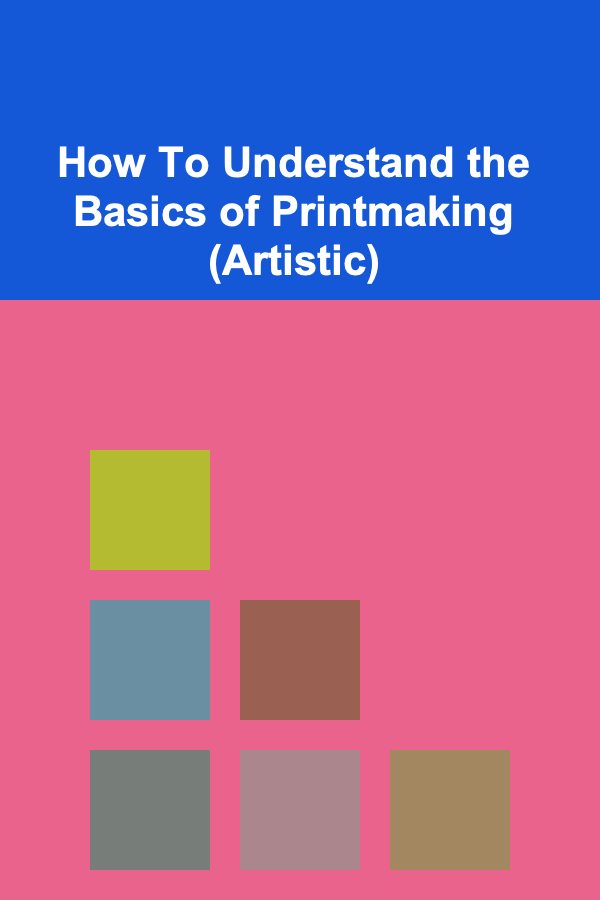
How To Understand the Basics of Printmaking (Artistic)
ebook include PDF & Audio bundle (Micro Guide)
$12.99$8.99
Limited Time Offer! Order within the next:

Printmaking is an ancient and diverse artistic medium that involves creating artworks by transferring ink or other materials onto a surface, typically paper, through a process that involves various methods and techniques. From its origins as a method for reproduction to its development as a unique form of artistic expression, printmaking has evolved into an exciting and multifaceted craft. In this article, we will explore the basics of printmaking, providing an in-depth understanding of its history, techniques, tools, and its importance in contemporary art.
What is Printmaking?
Printmaking is the process of creating images, patterns, or designs through the transfer of ink from a matrix (a surface that holds the image) to a substrate (usually paper or fabric). The matrix can be made from a variety of materials, including metal, wood, linoleum, or even digital surfaces. Unlike other visual arts, such as painting or sculpture, printmaking allows for the creation of multiple copies of an artwork, making it one of the earliest forms of mass production.
While printmaking began as a method for reproducing text and images, it has grown into a powerful artistic medium. Artists use printmaking not only to produce multiple copies of a design but also to experiment with textures, layering, and image manipulation. As a result, printmaking is a versatile and expressive medium that can produce a wide variety of visual effects.
History of Printmaking
The history of printmaking dates back to ancient civilizations, where it was primarily used for the reproduction of texts and illustrations. Early printmaking techniques included woodcuts and stamp printing, with origins in China and Japan. The first known example of movable type printing was developed in China during the Tang Dynasty (618-907 CE). This method allowed for the mass production of written works and was later spread to Europe, revolutionizing the spread of information.
In the West, printmaking began to flourish during the Renaissance, with artists like Albrecht Dürer and Rembrandt van Rijn creating intricate woodcuts and etchings. These prints were often used to disseminate religious and scientific ideas, but they also became an essential part of the artistic process. Printmaking allowed artists to explore new techniques and express themselves in ways that were previously impossible through traditional methods of painting or drawing.
In the modern era, printmaking techniques have continued to evolve, with the advent of lithography, silkscreen printing, and digital printmaking. Today, printmaking is recognized as a legitimate and important art form, with contemporary artists utilizing both traditional methods and modern innovations to create unique, thought-provoking works of art.
Key Printmaking Techniques
Printmaking encompasses a variety of techniques, each with its own distinct process and artistic potential. Below are some of the most widely used methods in traditional and contemporary printmaking.
1. Relief Printing
Relief printing is one of the oldest and most well-known methods of printmaking. In this technique, the image is carved or cut into a surface, and the raised areas of the matrix hold the ink. The most common form of relief printing is woodcut, where an image is carved into a block of wood, and ink is applied to the surface. The woodblock is then pressed onto paper, transferring the inked image.
Woodcut printing dates back to ancient China, but it became particularly popular in Europe during the Renaissance. The simplicity and accessibility of relief printing made it a favored method for early printmakers. Other materials used in relief printing include linoleum (known as linocut) and rubber.
2. Intaglio Printing
Intaglio is the opposite of relief printing in that the image is carved into the surface of the matrix, and the ink is held in the recessed lines or areas. This technique involves using sharp tools to incise the image into a metal plate, usually copper or zinc. The plate is then inked, and the excess ink is wiped off, leaving ink only in the incised areas. The plate is pressed onto paper under great pressure to transfer the image.
There are several types of intaglio techniques, including:
- Engraving: The artist uses a burin to carve the image into the metal plate, creating fine, precise lines.
- Etching: A plate is coated with a thin layer of acid-resistant ground. The artist uses a needle to draw onto the surface, exposing the plate to acid. The acid eats away at the exposed areas, creating lines and textures.
- Aquatint: A variant of etching that creates areas of tone or shading by using a powdered resin that resists the acid.
Intaglio printing is known for its ability to produce highly detailed and textured prints. It was favored by artists like Rembrandt and Goya for its expressive qualities.
3. Lithography
Lithography is a planographic printmaking technique, meaning that the printing surface is flat rather than raised or incised. The process is based on the principle that oil and water do not mix. In lithography, an image is drawn onto a smooth stone or metal plate using an oily substance, such as a grease pencil or lithographic crayon. The plate is then moistened with water, and ink is applied. The ink adheres only to the areas that have been drawn on, and the plate is pressed onto paper to transfer the image.
Lithography was invented in the late 18th century by Alois Senefelder and revolutionized printmaking by allowing artists to create detailed and fluid images. It is particularly known for its ability to reproduce tones and subtle variations in texture.
4. Screen Printing (Silkscreen)
Screen printing, also known as silkscreen printing, is a method where a design is applied to a fabric or paper through a mesh screen. The artist creates a stencil of the image, which is placed on a screen made of fine mesh. Ink is then forced through the mesh using a squeegee, leaving the design on the surface below.
Screen printing gained popularity in the mid-20th century, particularly in the world of commercial art and advertising. It became especially famous in the art world through the work of artists like Andy Warhol, who used the technique to create his iconic pop art prints. Silkscreen printing allows for vibrant colors and bold imagery, making it a favorite medium for contemporary artists.
5. Monotype
Monotype is a unique form of printmaking in which an image is painted or drawn directly onto a smooth, non-absorbent surface (such as a metal plate or acrylic sheet). The image is then transferred to paper by pressing the plate onto the paper. Unlike other printmaking techniques, which produce multiple copies, monotype results in a single, one-of-a-kind print.
Monotypes are known for their painterly qualities, as they allow for a combination of printmaking and painting techniques. This method is often used by artists who wish to explore spontaneous and experimental approaches to image-making.
6. Digital Printmaking
With the advent of digital technology, printmaking has expanded into the realm of digital art. Digital printmaking involves the creation of artwork using digital tools such as computers, tablets, and printers. The artist can use software to manipulate images and create intricate designs that are then printed onto paper or other surfaces.
Digital printmaking allows for greater flexibility, precision, and speed, making it an appealing choice for contemporary artists. It also opens up new possibilities for incorporating photography, digital painting, and other media into the printmaking process.
Tools and Materials for Printmaking
Printmaking requires a variety of tools and materials to create successful prints. These tools vary depending on the technique being used, but some common items include:
1. Presses
A printing press is often used to apply pressure to the matrix and substrate during the printing process. The type of press used depends on the printmaking technique. For example, an etching press is used for intaglio prints, while a lithography press is used for lithographic prints. Some artists may also use hand-operated presses or make use of manual techniques such as hand-burnishing.
2. Inks
Printmaking inks are specially formulated to adhere to the printing surface and transfer to the paper. Inks come in various types, such as oil-based, water-based, and acrylic, and the choice of ink depends on the technique being used.
3. Tools for Carving
In relief printmaking, artists use carving tools, such as gouges, knives, and chisels, to carve the image into the matrix. These tools come in a range of shapes and sizes, allowing for fine or bold carving.
4. Paper
The paper used in printmaking is crucial to the final result. Printmaking paper is typically thicker and more absorbent than regular paper to withstand the pressure of printing. Some printmakers prefer to use handmade or specialty papers for their prints.
5. Miscellaneous Tools
Other tools used in printmaking include brayers (rollers used to apply ink), masks, stencils, and various types of varnish or protective coatings.
The Role of Printmaking in Contemporary Art
Printmaking continues to play a vital role in the world of contemporary art. Today, many artists experiment with traditional and modern techniques, creating unique and innovative works of art. The versatility of printmaking allows for endless possibilities in terms of style, composition, and medium.
Contemporary printmaking often involves the blending of multiple techniques, such as combining intaglio with digital printing or using screen printing alongside painting. These hybrid approaches allow artists to push the boundaries of the medium and create prints that are visually exciting and conceptually rich.
Printmaking is also a significant part of the art market, with limited-edition prints being highly sought after by collectors. Many contemporary artists, such as Shepard Fairey and Damien Hirst, create limited-edition prints to complement their other works.
Conclusion
Printmaking is a rich and diverse art form with a long history and a bright future. Whether using traditional techniques like woodcut or etching, or exploring modern innovations such as digital printmaking, artists can create striking, thought-provoking works that push the boundaries of artistic expression. By understanding the basics of printmaking, artists and art enthusiasts alike can appreciate the technical skill, creativity, and passion that goes into creating beautiful prints.
Reading More From Our Other Websites
- [Metal Stamping Tip 101] Innovative Tools and Technologies Transforming Stainless Steel Stamping
- [Home Rental Property 101] How to Prepare Your Rental Property for Market Trends and Shifts
- [Ziplining Tip 101] Best Zipline Adventures Paired with Gourmet Farm‑to‑Table Dining Experiences
- [Home Budget Decorating 101] How to Repurpose Old Furniture into Beautiful Home Decor
- [Home Space Saving 101] How to Use Sliding Doors for Better Space Efficiency in Your Home
- [Home Security 101] How to Create a Safe and Secure Home Office with These Simple Steps
- [Organization Tip 101] How to Plan an Organized Move to a New Home
- [Metal Stamping Tip 101] Choosing the Right Metal Stamping Tooling for High‑Volume Production: A Decision‑Maker's Guide
- [Home Lighting 101] How to Select Unique Pendant Lights for Your Kitchen Island
- [Home Maintenance 101] How to Maintain Your Home's Air Ducts for Better Efficiency

How to Build a Morning Routine Checklist for Daily Success
Read More
How to Build a Tire Maintenance Checklist for Your Car
Read More
How to Keep Track of Your Fitness Equipment Inventory
Read More
How to Use Project Management Software to Make Money
Read More
How to Use Wall Decals for Quick and Affordable Home Updates
Read More
How to Select and Style Throw Pillows
Read MoreOther Products

How to Build a Morning Routine Checklist for Daily Success
Read More
How to Build a Tire Maintenance Checklist for Your Car
Read More
How to Keep Track of Your Fitness Equipment Inventory
Read More
How to Use Project Management Software to Make Money
Read More
How to Use Wall Decals for Quick and Affordable Home Updates
Read More